Dissertation: Value Chain Management Strategies in Taiwan's High-Tech
VerifiedAdded on 2020/01/28
|32
|5607
|45
Thesis and Dissertation
AI Summary
This dissertation chapter presents the results of an investigation into the value chain management strategies employed by Original Design Manufacturers (ODM) and Original Brand Manufacturers (OBM) in Taiwan's high-tech industry. The study aims to understand how these two types of manufacturers gain competitive advantages and achieve business sustainability. Data was collected from managers in ODM and OBM organizations through primary research, and analyzed using SPSS Statistics 20 software, including frequency analysis and MANOVA. The findings reveal significant differences in strategic priorities: ODM companies prioritize cost reduction and product development, while OBM companies focus on product development and brand/marketing channels. The analysis also explores how these manufacturers respond to competitive pressures, supplier relationships, and customer bargaining power. The study concludes with an assessment of how these firms adapt their value chain strategies in response to changes in the market, the launch of new substitute products and also examines strategies for long-term business success.

DISSERTATION CHAPTER – RESULTS
Paraphrase This Document
Need a fresh take? Get an instant paraphrase of this document with our AI Paraphraser
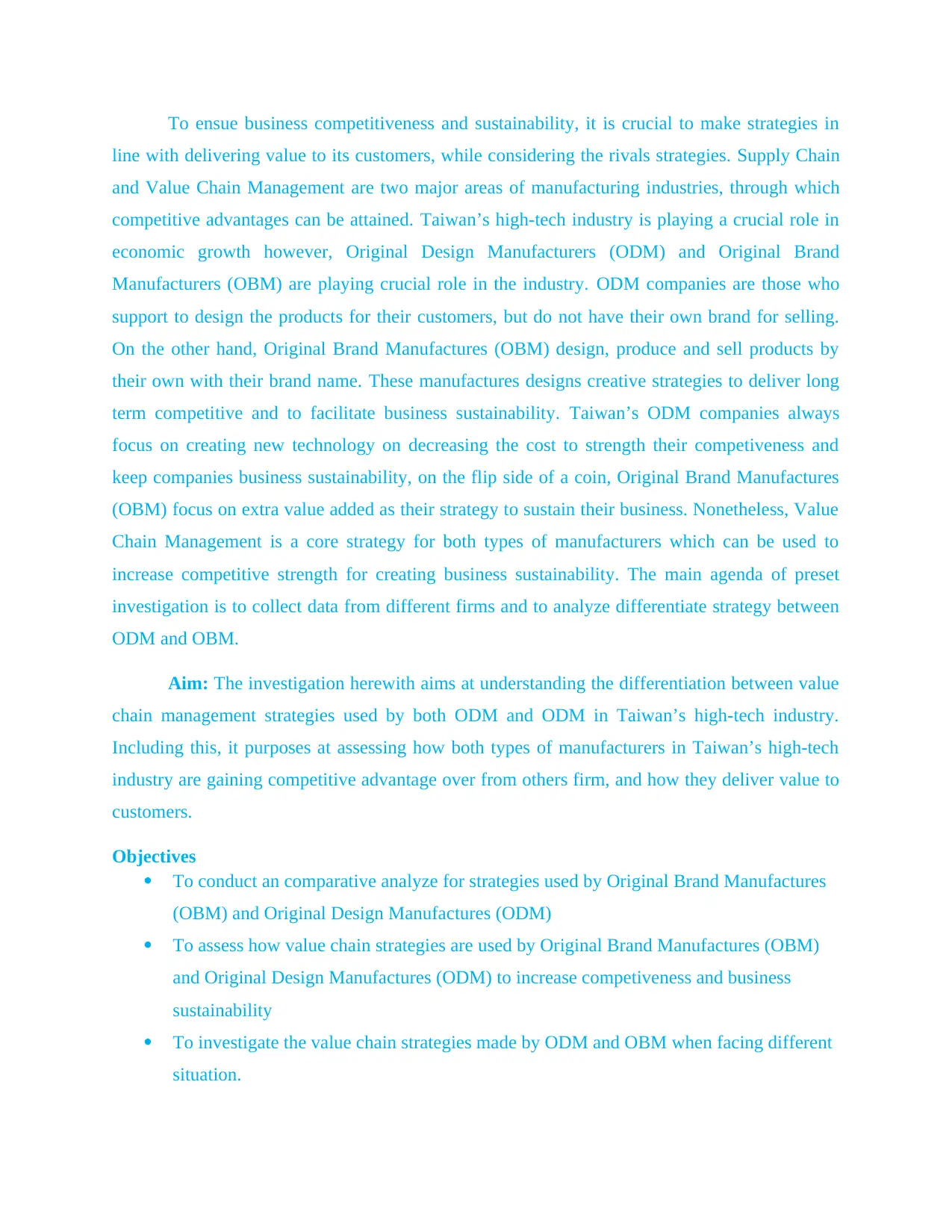
To ensue business competitiveness and sustainability, it is crucial to make strategies in
line with delivering value to its customers, while considering the rivals strategies. Supply Chain
and Value Chain Management are two major areas of manufacturing industries, through which
competitive advantages can be attained. Taiwan’s high-tech industry is playing a crucial role in
economic growth however, Original Design Manufacturers (ODM) and Original Brand
Manufacturers (OBM) are playing crucial role in the industry. ODM companies are those who
support to design the products for their customers, but do not have their own brand for selling.
On the other hand, Original Brand Manufactures (OBM) design, produce and sell products by
their own with their brand name. These manufactures designs creative strategies to deliver long
term competitive and to facilitate business sustainability. Taiwan’s ODM companies always
focus on creating new technology on decreasing the cost to strength their competiveness and
keep companies business sustainability, on the flip side of a coin, Original Brand Manufactures
(OBM) focus on extra value added as their strategy to sustain their business. Nonetheless, Value
Chain Management is a core strategy for both types of manufacturers which can be used to
increase competitive strength for creating business sustainability. The main agenda of preset
investigation is to collect data from different firms and to analyze differentiate strategy between
ODM and OBM.
Aim: The investigation herewith aims at understanding the differentiation between value
chain management strategies used by both ODM and ODM in Taiwan’s high-tech industry.
Including this, it purposes at assessing how both types of manufacturers in Taiwan’s high-tech
industry are gaining competitive advantage over from others firm, and how they deliver value to
customers.
Objectives
To conduct an comparative analyze for strategies used by Original Brand Manufactures
(OBM) and Original Design Manufactures (ODM)
To assess how value chain strategies are used by Original Brand Manufactures (OBM)
and Original Design Manufactures (ODM) to increase competiveness and business
sustainability
To investigate the value chain strategies made by ODM and OBM when facing different
situation.
line with delivering value to its customers, while considering the rivals strategies. Supply Chain
and Value Chain Management are two major areas of manufacturing industries, through which
competitive advantages can be attained. Taiwan’s high-tech industry is playing a crucial role in
economic growth however, Original Design Manufacturers (ODM) and Original Brand
Manufacturers (OBM) are playing crucial role in the industry. ODM companies are those who
support to design the products for their customers, but do not have their own brand for selling.
On the other hand, Original Brand Manufactures (OBM) design, produce and sell products by
their own with their brand name. These manufactures designs creative strategies to deliver long
term competitive and to facilitate business sustainability. Taiwan’s ODM companies always
focus on creating new technology on decreasing the cost to strength their competiveness and
keep companies business sustainability, on the flip side of a coin, Original Brand Manufactures
(OBM) focus on extra value added as their strategy to sustain their business. Nonetheless, Value
Chain Management is a core strategy for both types of manufacturers which can be used to
increase competitive strength for creating business sustainability. The main agenda of preset
investigation is to collect data from different firms and to analyze differentiate strategy between
ODM and OBM.
Aim: The investigation herewith aims at understanding the differentiation between value
chain management strategies used by both ODM and ODM in Taiwan’s high-tech industry.
Including this, it purposes at assessing how both types of manufacturers in Taiwan’s high-tech
industry are gaining competitive advantage over from others firm, and how they deliver value to
customers.
Objectives
To conduct an comparative analyze for strategies used by Original Brand Manufactures
(OBM) and Original Design Manufactures (ODM)
To assess how value chain strategies are used by Original Brand Manufactures (OBM)
and Original Design Manufactures (ODM) to increase competiveness and business
sustainability
To investigate the value chain strategies made by ODM and OBM when facing different
situation.
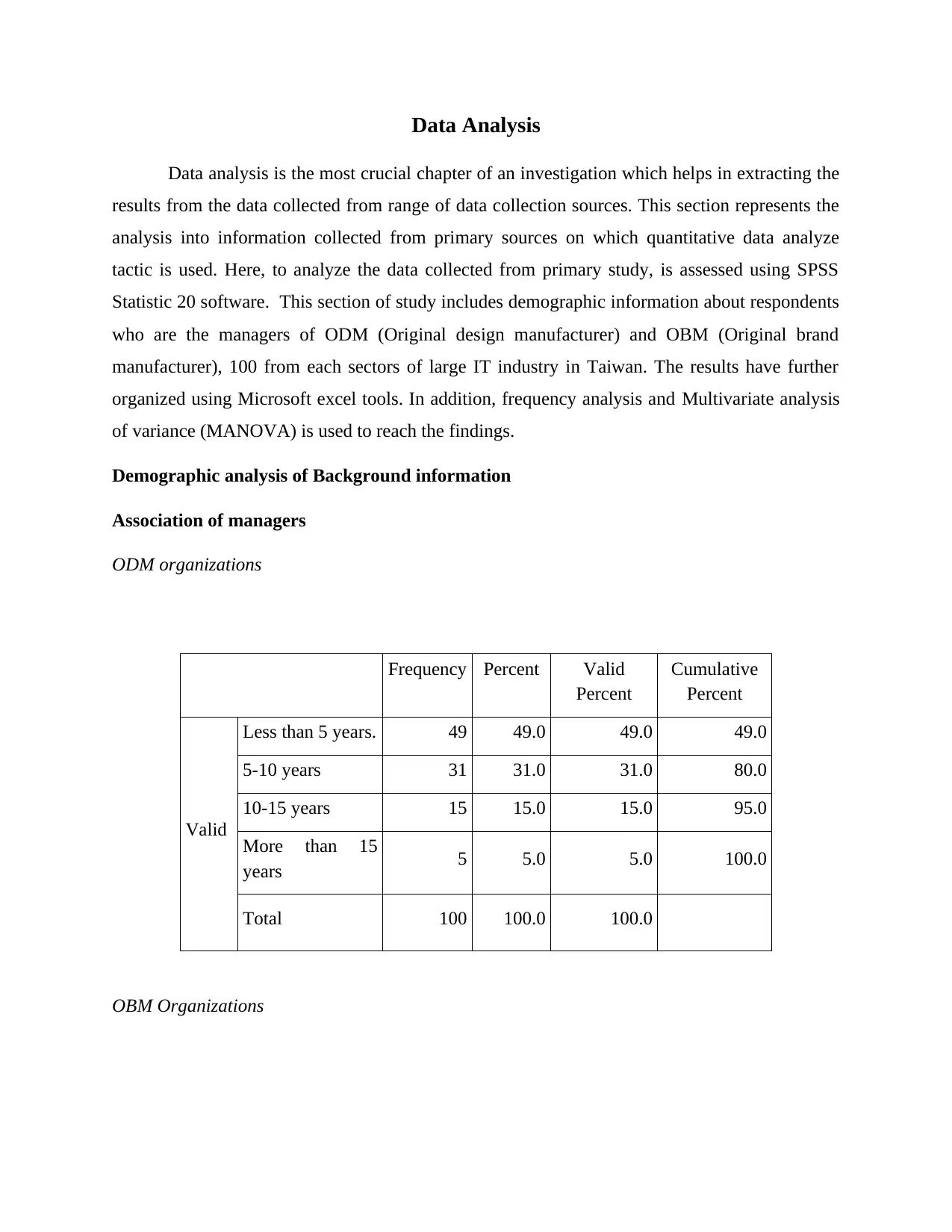
Data Analysis
Data analysis is the most crucial chapter of an investigation which helps in extracting the
results from the data collected from range of data collection sources. This section represents the
analysis into information collected from primary sources on which quantitative data analyze
tactic is used. Here, to analyze the data collected from primary study, is assessed using SPSS
Statistic 20 software. This section of study includes demographic information about respondents
who are the managers of ODM (Original design manufacturer) and OBM (Original brand
manufacturer), 100 from each sectors of large IT industry in Taiwan. The results have further
organized using Microsoft excel tools. In addition, frequency analysis and Multivariate analysis
of variance (MANOVA) is used to reach the findings.
Demographic analysis of Background information
Association of managers
ODM organizations
Frequency Percent Valid
Percent
Cumulative
Percent
Valid
Less than 5 years. 49 49.0 49.0 49.0
5-10 years 31 31.0 31.0 80.0
10-15 years 15 15.0 15.0 95.0
More than 15
years 5 5.0 5.0 100.0
Total 100 100.0 100.0
OBM Organizations
Data analysis is the most crucial chapter of an investigation which helps in extracting the
results from the data collected from range of data collection sources. This section represents the
analysis into information collected from primary sources on which quantitative data analyze
tactic is used. Here, to analyze the data collected from primary study, is assessed using SPSS
Statistic 20 software. This section of study includes demographic information about respondents
who are the managers of ODM (Original design manufacturer) and OBM (Original brand
manufacturer), 100 from each sectors of large IT industry in Taiwan. The results have further
organized using Microsoft excel tools. In addition, frequency analysis and Multivariate analysis
of variance (MANOVA) is used to reach the findings.
Demographic analysis of Background information
Association of managers
ODM organizations
Frequency Percent Valid
Percent
Cumulative
Percent
Valid
Less than 5 years. 49 49.0 49.0 49.0
5-10 years 31 31.0 31.0 80.0
10-15 years 15 15.0 15.0 95.0
More than 15
years 5 5.0 5.0 100.0
Total 100 100.0 100.0
OBM Organizations
⊘ This is a preview!⊘
Do you want full access?
Subscribe today to unlock all pages.

Trusted by 1+ million students worldwide
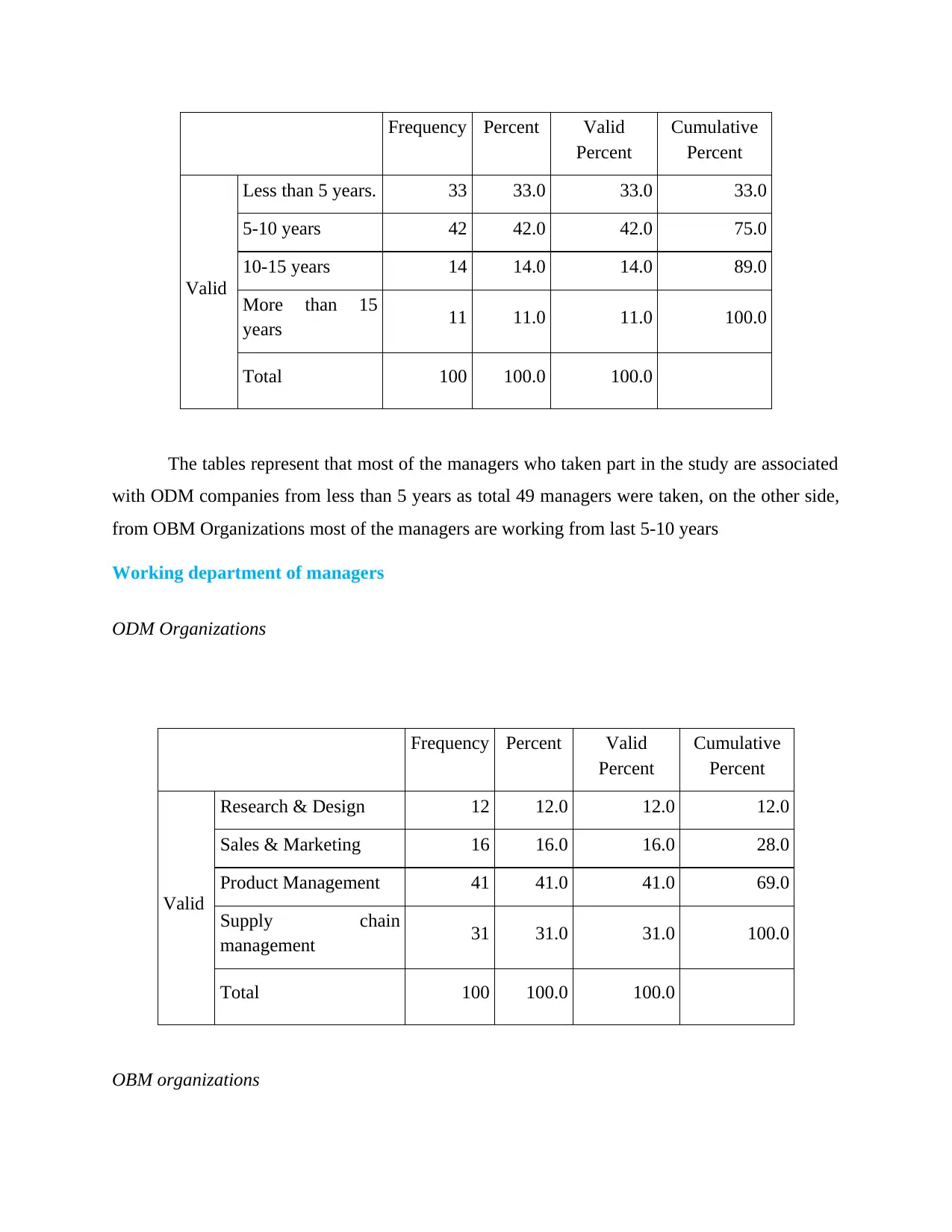
Frequency Percent Valid
Percent
Cumulative
Percent
Valid
Less than 5 years. 33 33.0 33.0 33.0
5-10 years 42 42.0 42.0 75.0
10-15 years 14 14.0 14.0 89.0
More than 15
years 11 11.0 11.0 100.0
Total 100 100.0 100.0
The tables represent that most of the managers who taken part in the study are associated
with ODM companies from less than 5 years as total 49 managers were taken, on the other side,
from OBM Organizations most of the managers are working from last 5-10 years
Working department of managers
ODM Organizations
Frequency Percent Valid
Percent
Cumulative
Percent
Valid
Research & Design 12 12.0 12.0 12.0
Sales & Marketing 16 16.0 16.0 28.0
Product Management 41 41.0 41.0 69.0
Supply chain
management 31 31.0 31.0 100.0
Total 100 100.0 100.0
OBM organizations
Percent
Cumulative
Percent
Valid
Less than 5 years. 33 33.0 33.0 33.0
5-10 years 42 42.0 42.0 75.0
10-15 years 14 14.0 14.0 89.0
More than 15
years 11 11.0 11.0 100.0
Total 100 100.0 100.0
The tables represent that most of the managers who taken part in the study are associated
with ODM companies from less than 5 years as total 49 managers were taken, on the other side,
from OBM Organizations most of the managers are working from last 5-10 years
Working department of managers
ODM Organizations
Frequency Percent Valid
Percent
Cumulative
Percent
Valid
Research & Design 12 12.0 12.0 12.0
Sales & Marketing 16 16.0 16.0 28.0
Product Management 41 41.0 41.0 69.0
Supply chain
management 31 31.0 31.0 100.0
Total 100 100.0 100.0
OBM organizations
Paraphrase This Document
Need a fresh take? Get an instant paraphrase of this document with our AI Paraphraser
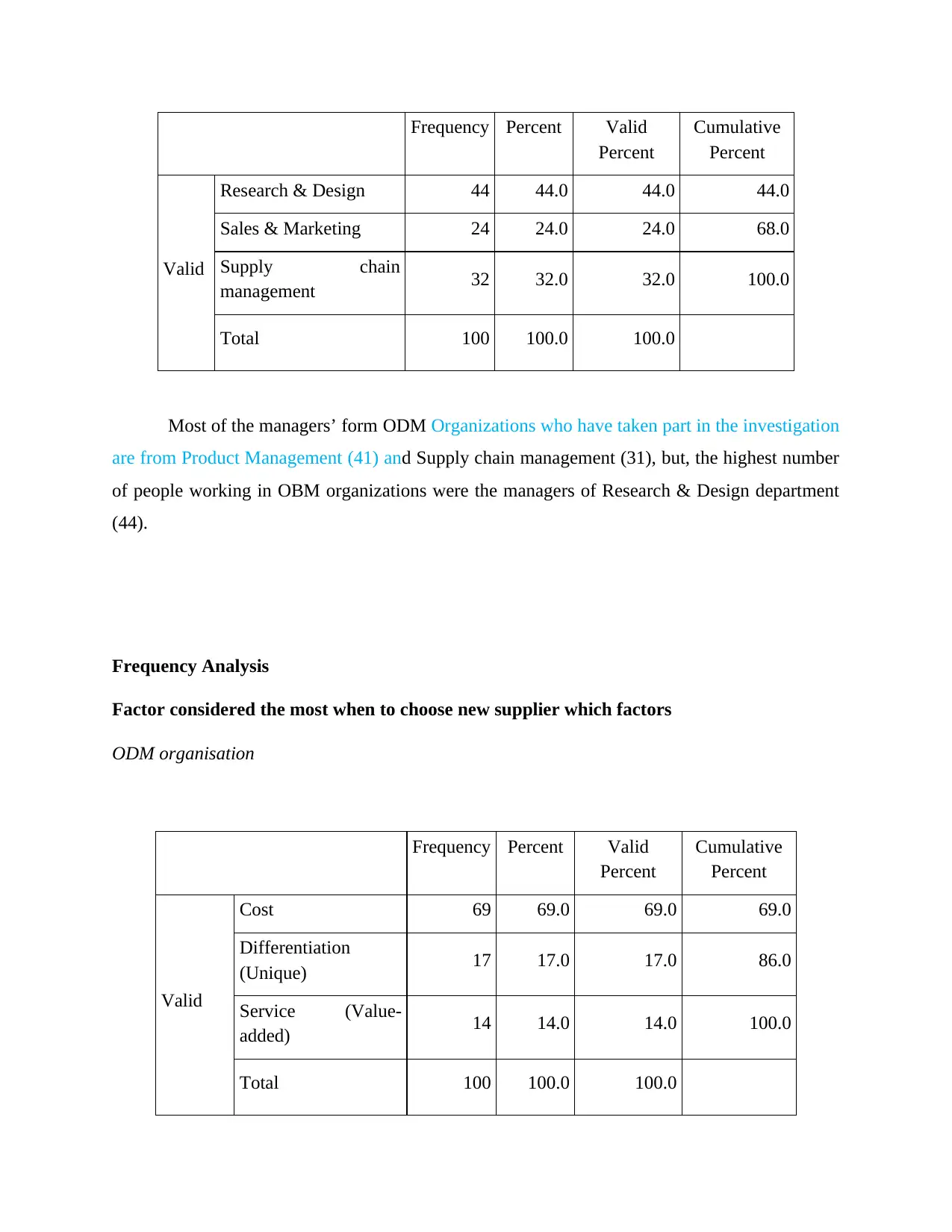
Frequency Percent Valid
Percent
Cumulative
Percent
Valid
Research & Design 44 44.0 44.0 44.0
Sales & Marketing 24 24.0 24.0 68.0
Supply chain
management 32 32.0 32.0 100.0
Total 100 100.0 100.0
Most of the managers’ form ODM Organizations who have taken part in the investigation
are from Product Management (41) and Supply chain management (31), but, the highest number
of people working in OBM organizations were the managers of Research & Design department
(44).
Frequency Analysis
Factor considered the most when to choose new supplier which factors
ODM organisation
Frequency Percent Valid
Percent
Cumulative
Percent
Valid
Cost 69 69.0 69.0 69.0
Differentiation
(Unique) 17 17.0 17.0 86.0
Service (Value-
added) 14 14.0 14.0 100.0
Total 100 100.0 100.0
Percent
Cumulative
Percent
Valid
Research & Design 44 44.0 44.0 44.0
Sales & Marketing 24 24.0 24.0 68.0
Supply chain
management 32 32.0 32.0 100.0
Total 100 100.0 100.0
Most of the managers’ form ODM Organizations who have taken part in the investigation
are from Product Management (41) and Supply chain management (31), but, the highest number
of people working in OBM organizations were the managers of Research & Design department
(44).
Frequency Analysis
Factor considered the most when to choose new supplier which factors
ODM organisation
Frequency Percent Valid
Percent
Cumulative
Percent
Valid
Cost 69 69.0 69.0 69.0
Differentiation
(Unique) 17 17.0 17.0 86.0
Service (Value-
added) 14 14.0 14.0 100.0
Total 100 100.0 100.0
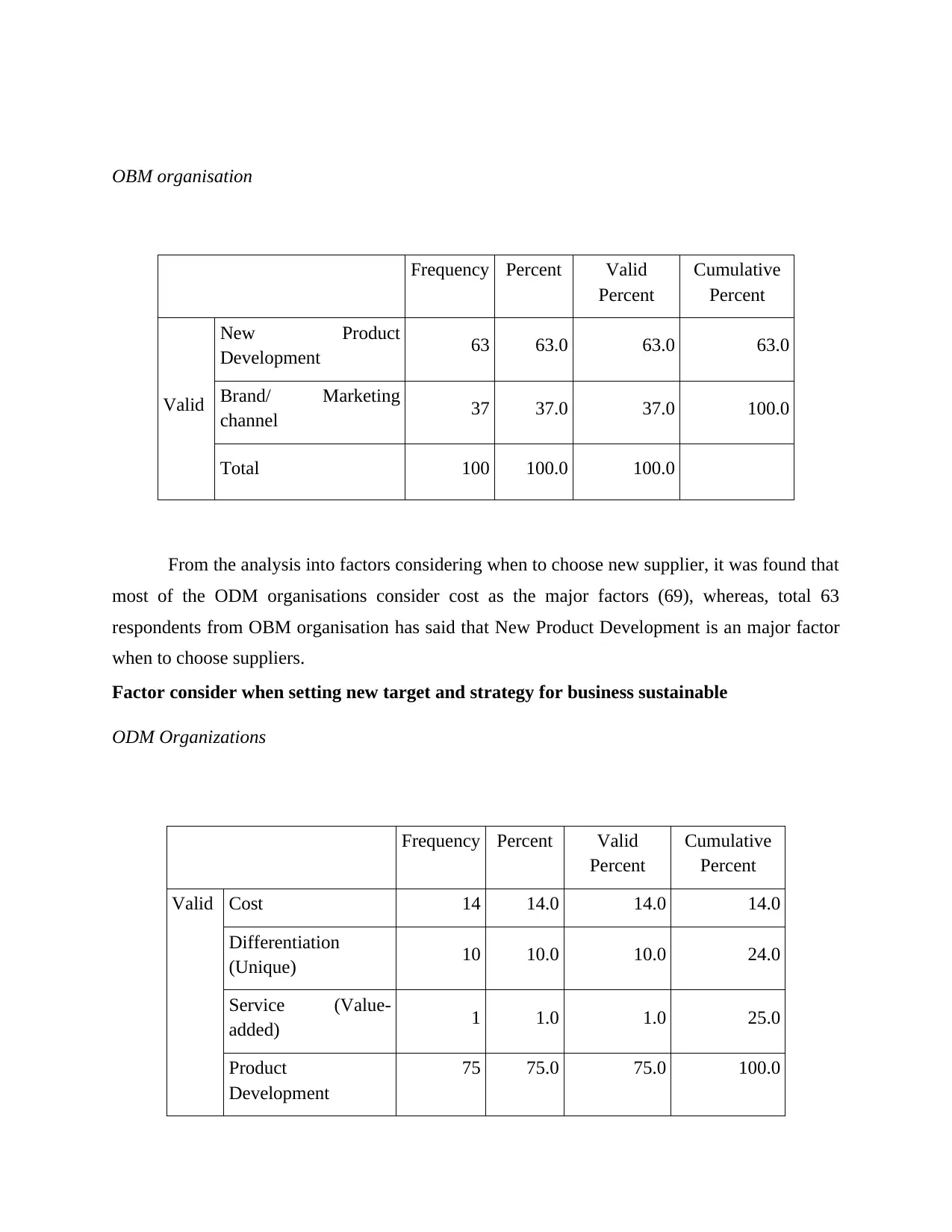
OBM organisation
Frequency Percent Valid
Percent
Cumulative
Percent
Valid
New Product
Development 63 63.0 63.0 63.0
Brand/ Marketing
channel 37 37.0 37.0 100.0
Total 100 100.0 100.0
From the analysis into factors considering when to choose new supplier, it was found that
most of the ODM organisations consider cost as the major factors (69), whereas, total 63
respondents from OBM organisation has said that New Product Development is an major factor
when to choose suppliers.
Factor consider when setting new target and strategy for business sustainable
ODM Organizations
Frequency Percent Valid
Percent
Cumulative
Percent
Valid Cost 14 14.0 14.0 14.0
Differentiation
(Unique) 10 10.0 10.0 24.0
Service (Value-
added) 1 1.0 1.0 25.0
Product
Development
75 75.0 75.0 100.0
Frequency Percent Valid
Percent
Cumulative
Percent
Valid
New Product
Development 63 63.0 63.0 63.0
Brand/ Marketing
channel 37 37.0 37.0 100.0
Total 100 100.0 100.0
From the analysis into factors considering when to choose new supplier, it was found that
most of the ODM organisations consider cost as the major factors (69), whereas, total 63
respondents from OBM organisation has said that New Product Development is an major factor
when to choose suppliers.
Factor consider when setting new target and strategy for business sustainable
ODM Organizations
Frequency Percent Valid
Percent
Cumulative
Percent
Valid Cost 14 14.0 14.0 14.0
Differentiation
(Unique) 10 10.0 10.0 24.0
Service (Value-
added) 1 1.0 1.0 25.0
Product
Development
75 75.0 75.0 100.0
⊘ This is a preview!⊘
Do you want full access?
Subscribe today to unlock all pages.

Trusted by 1+ million students worldwide
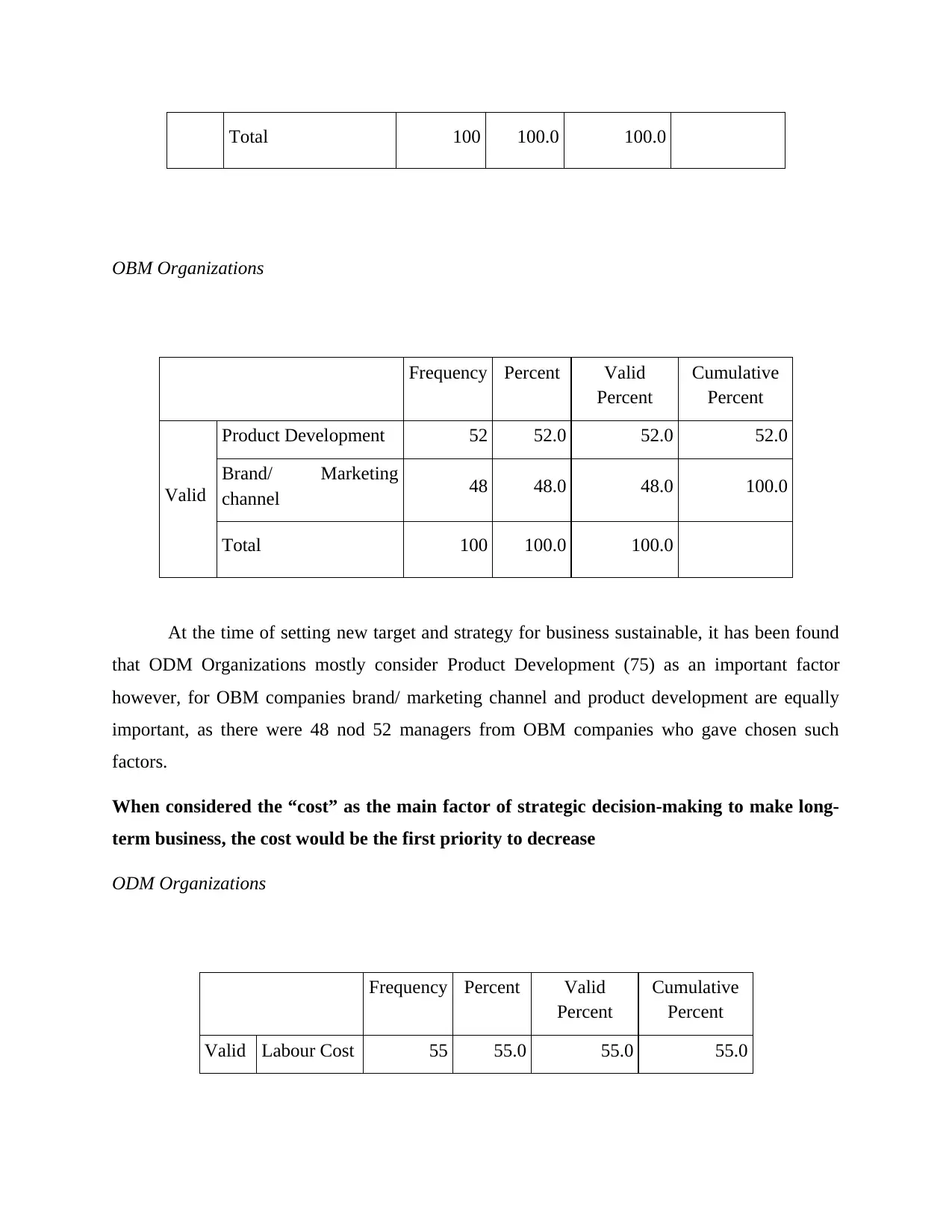
Total 100 100.0 100.0
OBM Organizations
Frequency Percent Valid
Percent
Cumulative
Percent
Valid
Product Development 52 52.0 52.0 52.0
Brand/ Marketing
channel 48 48.0 48.0 100.0
Total 100 100.0 100.0
At the time of setting new target and strategy for business sustainable, it has been found
that ODM Organizations mostly consider Product Development (75) as an important factor
however, for OBM companies brand/ marketing channel and product development are equally
important, as there were 48 nod 52 managers from OBM companies who gave chosen such
factors.
When considered the “cost” as the main factor of strategic decision-making to make long-
term business, the cost would be the first priority to decrease
ODM Organizations
Frequency Percent Valid
Percent
Cumulative
Percent
Valid Labour Cost 55 55.0 55.0 55.0
OBM Organizations
Frequency Percent Valid
Percent
Cumulative
Percent
Valid
Product Development 52 52.0 52.0 52.0
Brand/ Marketing
channel 48 48.0 48.0 100.0
Total 100 100.0 100.0
At the time of setting new target and strategy for business sustainable, it has been found
that ODM Organizations mostly consider Product Development (75) as an important factor
however, for OBM companies brand/ marketing channel and product development are equally
important, as there were 48 nod 52 managers from OBM companies who gave chosen such
factors.
When considered the “cost” as the main factor of strategic decision-making to make long-
term business, the cost would be the first priority to decrease
ODM Organizations
Frequency Percent Valid
Percent
Cumulative
Percent
Valid Labour Cost 55 55.0 55.0 55.0
Paraphrase This Document
Need a fresh take? Get an instant paraphrase of this document with our AI Paraphraser
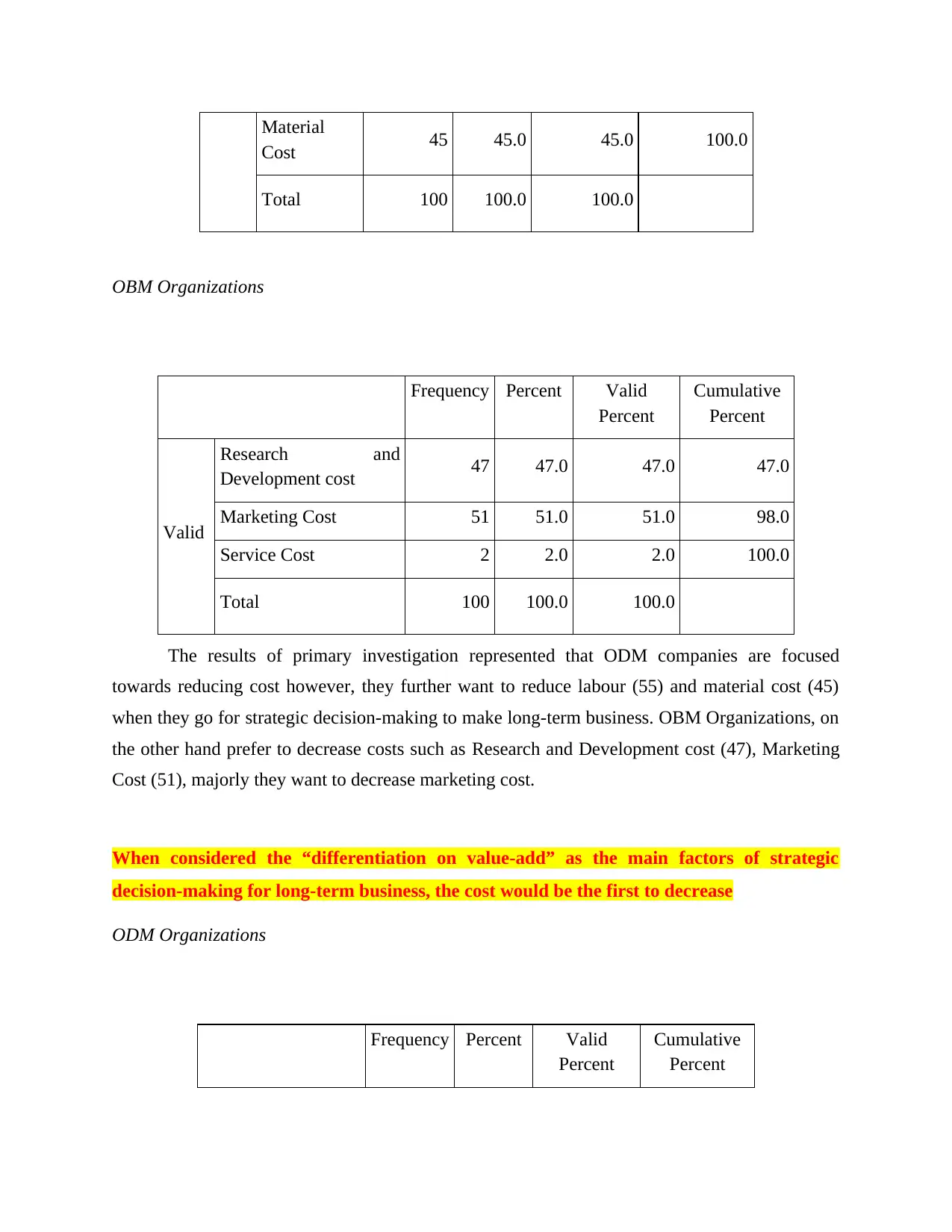
Material
Cost 45 45.0 45.0 100.0
Total 100 100.0 100.0
OBM Organizations
Frequency Percent Valid
Percent
Cumulative
Percent
Valid
Research and
Development cost 47 47.0 47.0 47.0
Marketing Cost 51 51.0 51.0 98.0
Service Cost 2 2.0 2.0 100.0
Total 100 100.0 100.0
The results of primary investigation represented that ODM companies are focused
towards reducing cost however, they further want to reduce labour (55) and material cost (45)
when they go for strategic decision-making to make long-term business. OBM Organizations, on
the other hand prefer to decrease costs such as Research and Development cost (47), Marketing
Cost (51), majorly they want to decrease marketing cost.
When considered the “differentiation on value-add” as the main factors of strategic
decision-making for long-term business, the cost would be the first to decrease
ODM Organizations
Frequency Percent Valid
Percent
Cumulative
Percent
Cost 45 45.0 45.0 100.0
Total 100 100.0 100.0
OBM Organizations
Frequency Percent Valid
Percent
Cumulative
Percent
Valid
Research and
Development cost 47 47.0 47.0 47.0
Marketing Cost 51 51.0 51.0 98.0
Service Cost 2 2.0 2.0 100.0
Total 100 100.0 100.0
The results of primary investigation represented that ODM companies are focused
towards reducing cost however, they further want to reduce labour (55) and material cost (45)
when they go for strategic decision-making to make long-term business. OBM Organizations, on
the other hand prefer to decrease costs such as Research and Development cost (47), Marketing
Cost (51), majorly they want to decrease marketing cost.
When considered the “differentiation on value-add” as the main factors of strategic
decision-making for long-term business, the cost would be the first to decrease
ODM Organizations
Frequency Percent Valid
Percent
Cumulative
Percent
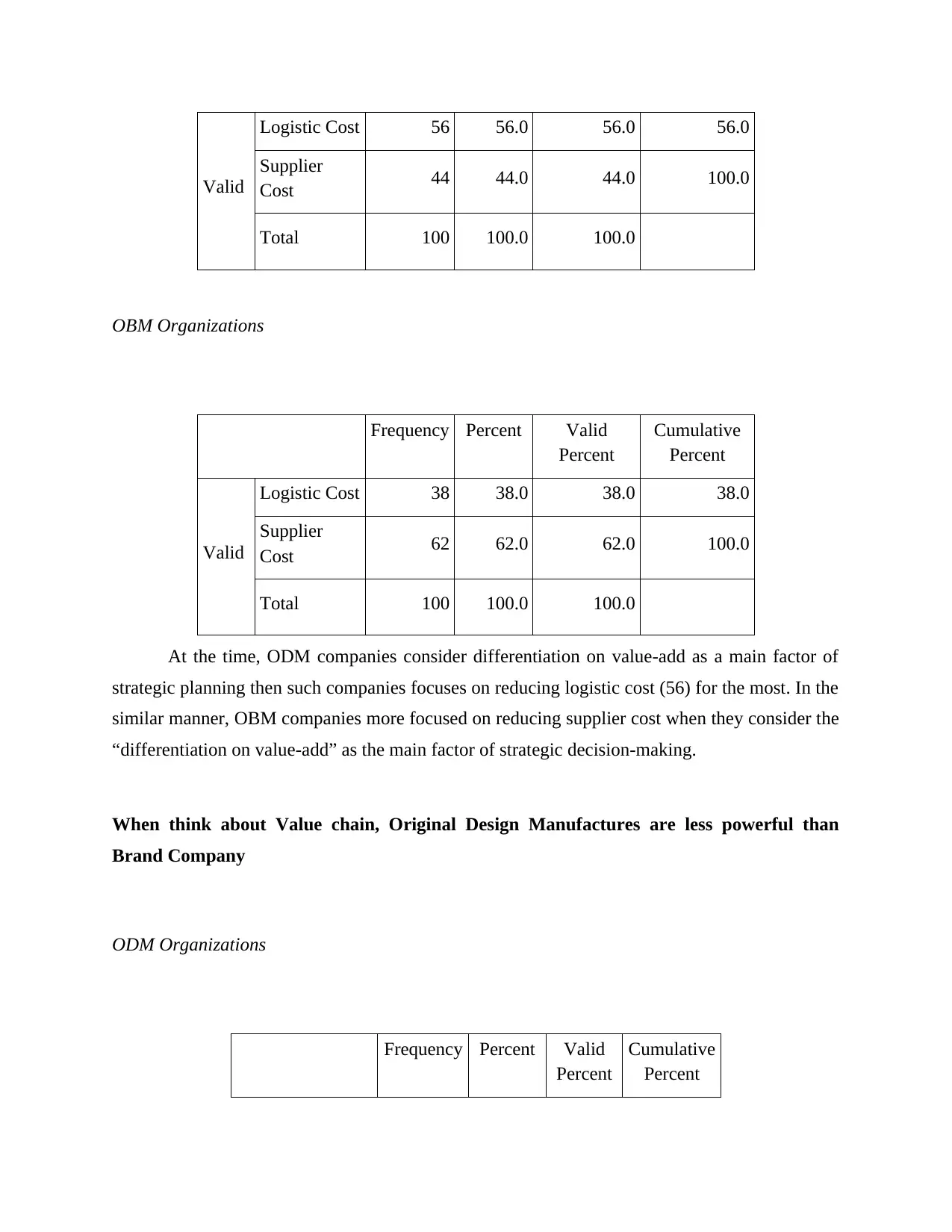
Valid
Logistic Cost 56 56.0 56.0 56.0
Supplier
Cost 44 44.0 44.0 100.0
Total 100 100.0 100.0
OBM Organizations
Frequency Percent Valid
Percent
Cumulative
Percent
Valid
Logistic Cost 38 38.0 38.0 38.0
Supplier
Cost 62 62.0 62.0 100.0
Total 100 100.0 100.0
At the time, ODM companies consider differentiation on value-add as a main factor of
strategic planning then such companies focuses on reducing logistic cost (56) for the most. In the
similar manner, OBM companies more focused on reducing supplier cost when they consider the
“differentiation on value-add” as the main factor of strategic decision-making.
When think about Value chain, Original Design Manufactures are less powerful than
Brand Company
ODM Organizations
Frequency Percent Valid
Percent
Cumulative
Percent
Logistic Cost 56 56.0 56.0 56.0
Supplier
Cost 44 44.0 44.0 100.0
Total 100 100.0 100.0
OBM Organizations
Frequency Percent Valid
Percent
Cumulative
Percent
Valid
Logistic Cost 38 38.0 38.0 38.0
Supplier
Cost 62 62.0 62.0 100.0
Total 100 100.0 100.0
At the time, ODM companies consider differentiation on value-add as a main factor of
strategic planning then such companies focuses on reducing logistic cost (56) for the most. In the
similar manner, OBM companies more focused on reducing supplier cost when they consider the
“differentiation on value-add” as the main factor of strategic decision-making.
When think about Value chain, Original Design Manufactures are less powerful than
Brand Company
ODM Organizations
Frequency Percent Valid
Percent
Cumulative
Percent
⊘ This is a preview!⊘
Do you want full access?
Subscribe today to unlock all pages.

Trusted by 1+ million students worldwide
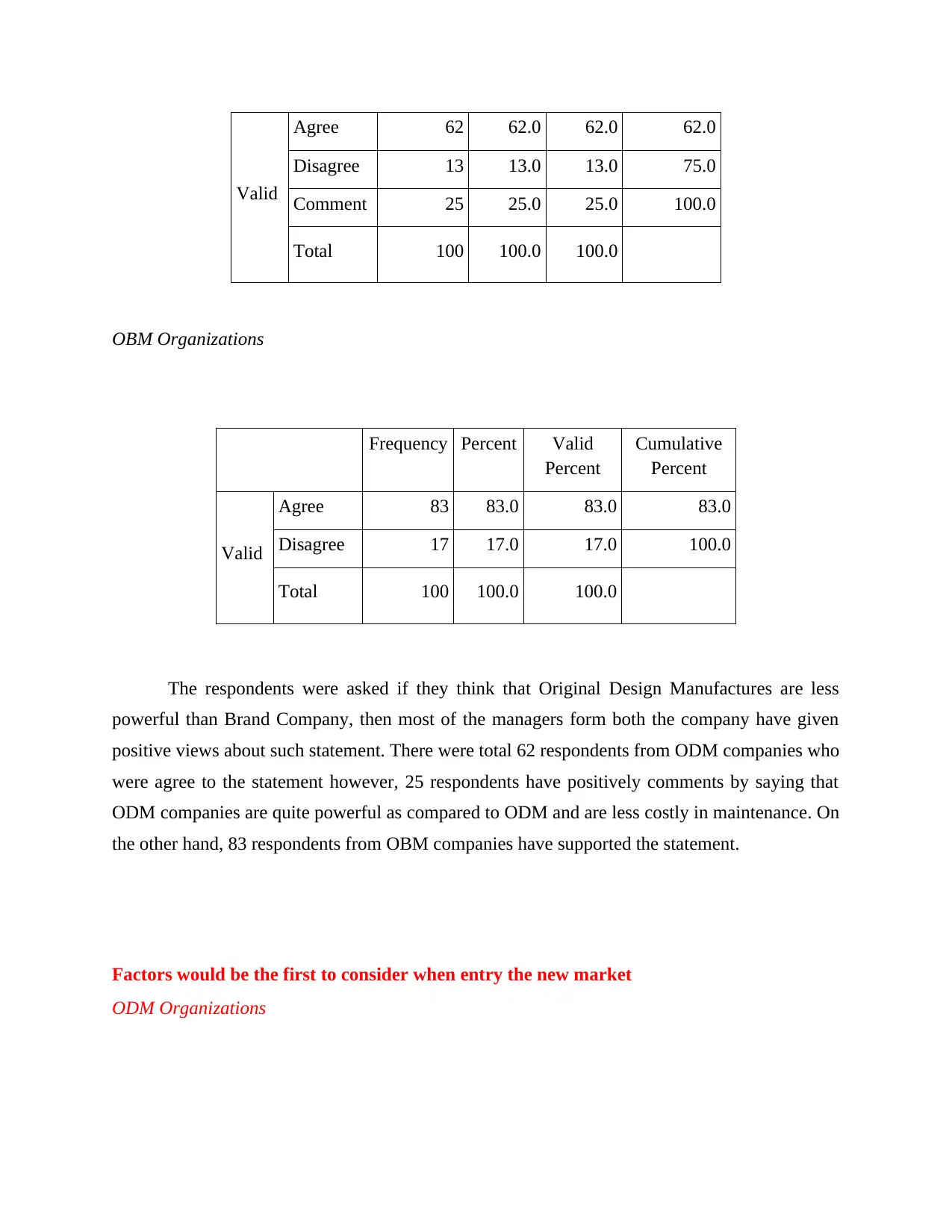
Valid
Agree 62 62.0 62.0 62.0
Disagree 13 13.0 13.0 75.0
Comment 25 25.0 25.0 100.0
Total 100 100.0 100.0
OBM Organizations
Frequency Percent Valid
Percent
Cumulative
Percent
Valid
Agree 83 83.0 83.0 83.0
Disagree 17 17.0 17.0 100.0
Total 100 100.0 100.0
The respondents were asked if they think that Original Design Manufactures are less
powerful than Brand Company, then most of the managers form both the company have given
positive views about such statement. There were total 62 respondents from ODM companies who
were agree to the statement however, 25 respondents have positively comments by saying that
ODM companies are quite powerful as compared to ODM and are less costly in maintenance. On
the other hand, 83 respondents from OBM companies have supported the statement.
Factors would be the first to consider when entry the new market
ODM Organizations
Agree 62 62.0 62.0 62.0
Disagree 13 13.0 13.0 75.0
Comment 25 25.0 25.0 100.0
Total 100 100.0 100.0
OBM Organizations
Frequency Percent Valid
Percent
Cumulative
Percent
Valid
Agree 83 83.0 83.0 83.0
Disagree 17 17.0 17.0 100.0
Total 100 100.0 100.0
The respondents were asked if they think that Original Design Manufactures are less
powerful than Brand Company, then most of the managers form both the company have given
positive views about such statement. There were total 62 respondents from ODM companies who
were agree to the statement however, 25 respondents have positively comments by saying that
ODM companies are quite powerful as compared to ODM and are less costly in maintenance. On
the other hand, 83 respondents from OBM companies have supported the statement.
Factors would be the first to consider when entry the new market
ODM Organizations
Paraphrase This Document
Need a fresh take? Get an instant paraphrase of this document with our AI Paraphraser
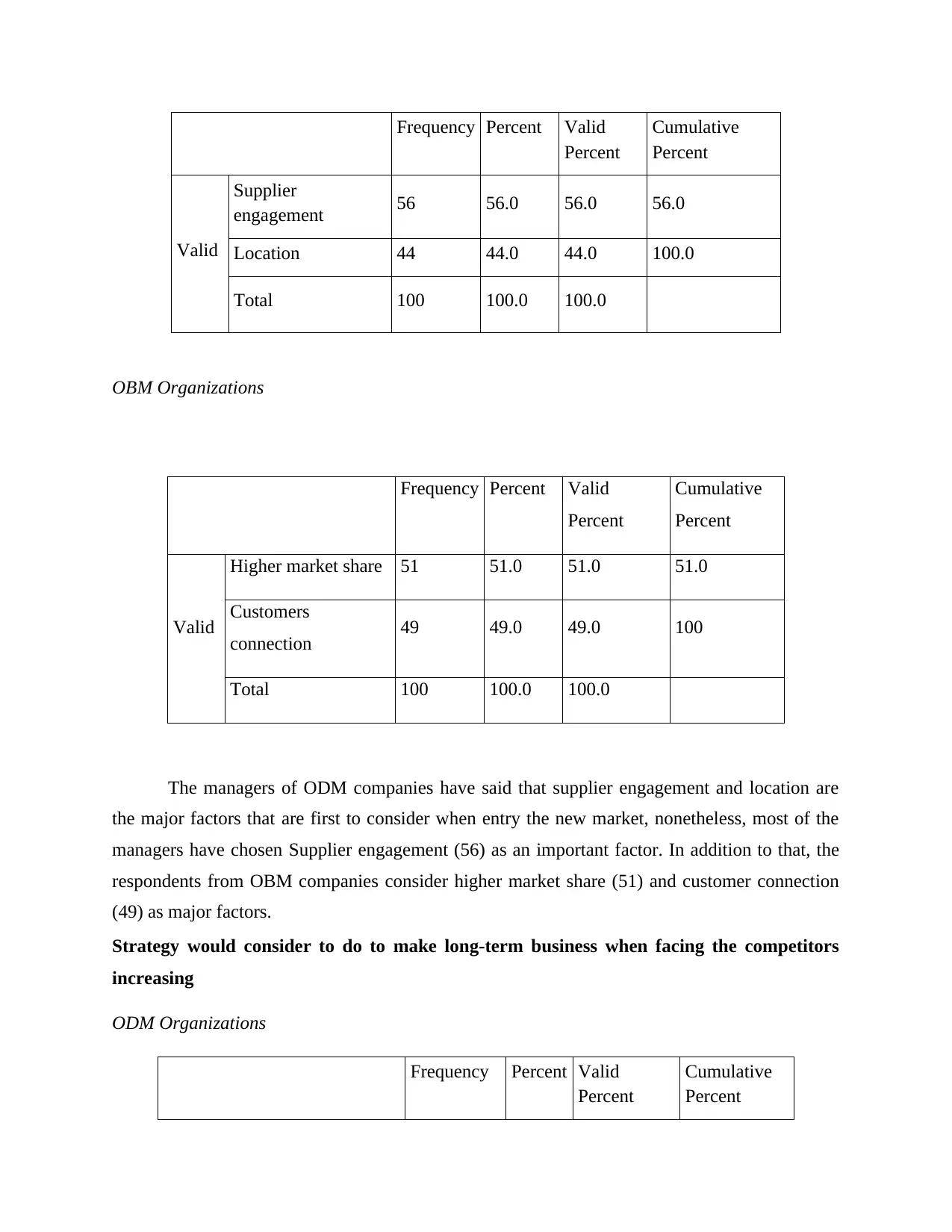
Frequency Percent Valid
Percent
Cumulative
Percent
Valid
Supplier
engagement 56 56.0 56.0 56.0
Location 44 44.0 44.0 100.0
Total 100 100.0 100.0
OBM Organizations
Frequency Percent Valid
Percent
Cumulative
Percent
Valid
Higher market share 51 51.0 51.0 51.0
Customers
connection 49 49.0 49.0 100
Total 100 100.0 100.0
The managers of ODM companies have said that supplier engagement and location are
the major factors that are first to consider when entry the new market, nonetheless, most of the
managers have chosen Supplier engagement (56) as an important factor. In addition to that, the
respondents from OBM companies consider higher market share (51) and customer connection
(49) as major factors.
Strategy would consider to do to make long-term business when facing the competitors
increasing
ODM Organizations
Frequency Percent Valid
Percent
Cumulative
Percent
Percent
Cumulative
Percent
Valid
Supplier
engagement 56 56.0 56.0 56.0
Location 44 44.0 44.0 100.0
Total 100 100.0 100.0
OBM Organizations
Frequency Percent Valid
Percent
Cumulative
Percent
Valid
Higher market share 51 51.0 51.0 51.0
Customers
connection 49 49.0 49.0 100
Total 100 100.0 100.0
The managers of ODM companies have said that supplier engagement and location are
the major factors that are first to consider when entry the new market, nonetheless, most of the
managers have chosen Supplier engagement (56) as an important factor. In addition to that, the
respondents from OBM companies consider higher market share (51) and customer connection
(49) as major factors.
Strategy would consider to do to make long-term business when facing the competitors
increasing
ODM Organizations
Frequency Percent Valid
Percent
Cumulative
Percent
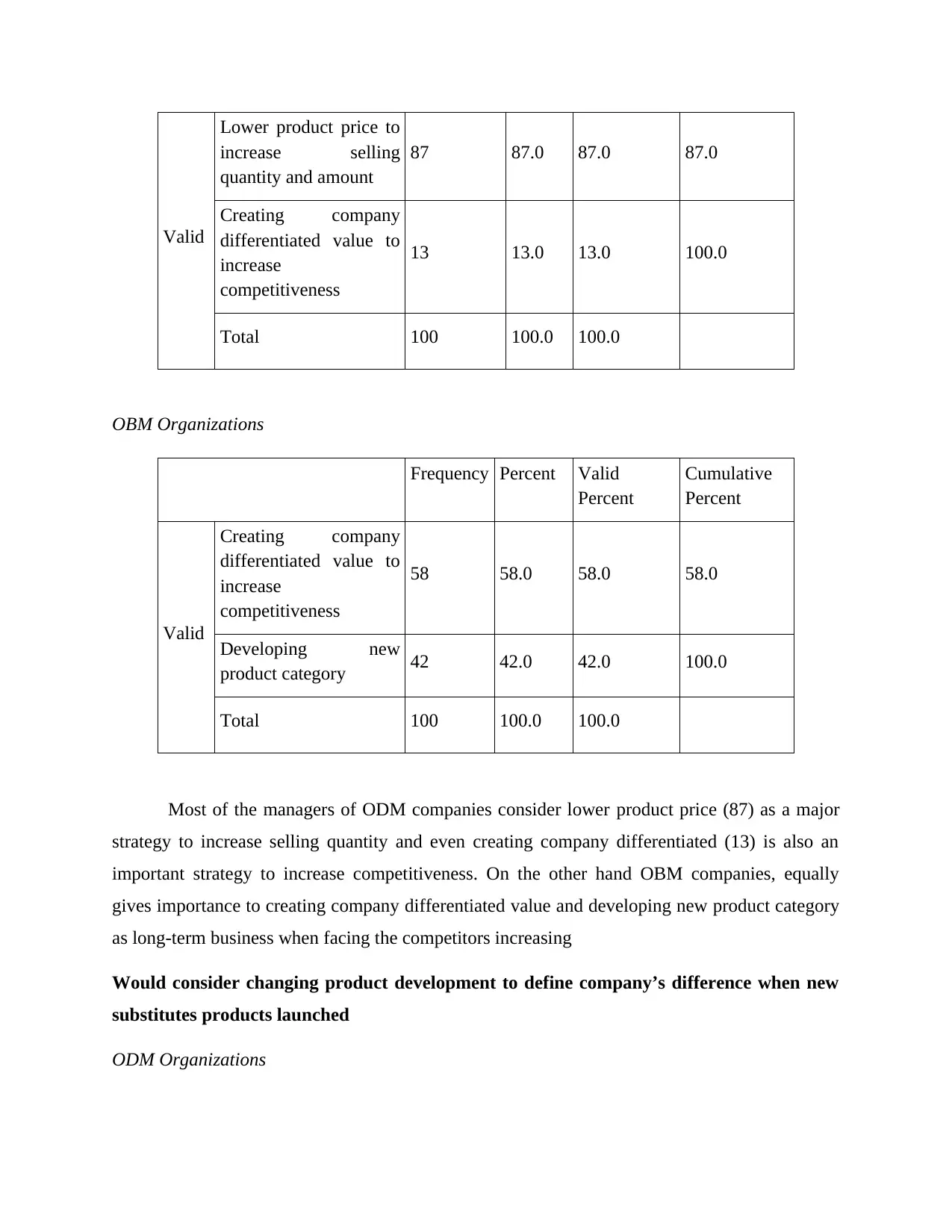
Valid
Lower product price to
increase selling
quantity and amount
87 87.0 87.0 87.0
Creating company
differentiated value to
increase
competitiveness
13 13.0 13.0 100.0
Total 100 100.0 100.0
OBM Organizations
Frequency Percent Valid
Percent
Cumulative
Percent
Valid
Creating company
differentiated value to
increase
competitiveness
58 58.0 58.0 58.0
Developing new
product category 42 42.0 42.0 100.0
Total 100 100.0 100.0
Most of the managers of ODM companies consider lower product price (87) as a major
strategy to increase selling quantity and even creating company differentiated (13) is also an
important strategy to increase competitiveness. On the other hand OBM companies, equally
gives importance to creating company differentiated value and developing new product category
as long-term business when facing the competitors increasing
Would consider changing product development to define company’s difference when new
substitutes products launched
ODM Organizations
Lower product price to
increase selling
quantity and amount
87 87.0 87.0 87.0
Creating company
differentiated value to
increase
competitiveness
13 13.0 13.0 100.0
Total 100 100.0 100.0
OBM Organizations
Frequency Percent Valid
Percent
Cumulative
Percent
Valid
Creating company
differentiated value to
increase
competitiveness
58 58.0 58.0 58.0
Developing new
product category 42 42.0 42.0 100.0
Total 100 100.0 100.0
Most of the managers of ODM companies consider lower product price (87) as a major
strategy to increase selling quantity and even creating company differentiated (13) is also an
important strategy to increase competitiveness. On the other hand OBM companies, equally
gives importance to creating company differentiated value and developing new product category
as long-term business when facing the competitors increasing
Would consider changing product development to define company’s difference when new
substitutes products launched
ODM Organizations
⊘ This is a preview!⊘
Do you want full access?
Subscribe today to unlock all pages.

Trusted by 1+ million students worldwide
1 out of 32
Related Documents
Your All-in-One AI-Powered Toolkit for Academic Success.
+13062052269
info@desklib.com
Available 24*7 on WhatsApp / Email
![[object Object]](/_next/static/media/star-bottom.7253800d.svg)
Unlock your academic potential
Copyright © 2020–2025 A2Z Services. All Rights Reserved. Developed and managed by ZUCOL.





